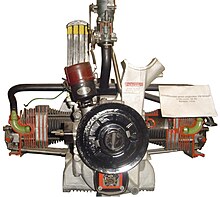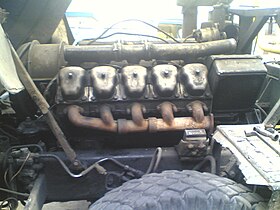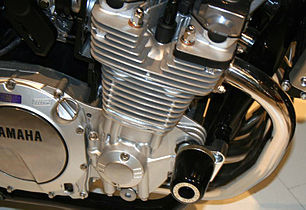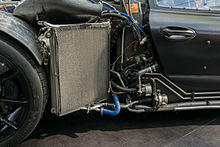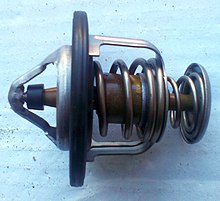Cooling (combustion engine)
The cooling system in an internal combustion engine mainly dissipates the heat that is given off by the hot gas to the walls of the combustion chamber and cylinder because the cycle is not ideal. Compared to electric motors , the efficiency is low and requires a correspondingly high cooling capacity. Temperatures that are too high damage the engine (the lubricating film tears off ( piston seizure ), the valves burn ). With Stirling engines , the process heat to be dissipated is given off via the cooling system.
Air and water cooling are used as the primary cooling system . With an oil cooler , the lubricant is often used for cooling - mostly with air cooling.
Air cooling
The metal lamellae around the cylinder and the cylinder head are characteristic. The significantly higher thermal conductivity in relation to the air dissipates the heat, the large surfaces facilitate the transition to the surrounding air.
use
In general, the air-cooled internal combustion engine has been largely replaced by liquid-cooled versions. In motor vehicles it is still used on some motorcycles , manufacturers such as Harley-Davidson , Buell , Ducati , Moto Guzzi or BMW have or had numerous models with air cooling in their product range. In the course of the EURO4 standard, many manufacturers have switched to water cooling. On the other hand, propellers - airplanes and RC cars with combustion engines are equipped with air-cooled motors, as well as small motors for lawnmowers or chainsaws . These engines often (like some motorcycle engines) do without a fan.
Air-cooled cars were always equipped with a fan . Such cars were recently produced in the form of the Porsche 911 with a 6-cylinder boxer engine (until 1998) and the Tatra 700 with an 8-cylinder V-engine (until 1999). Other historic passenger cars with air-cooled engines include VW Beetles , Citroën 2CV ("duck"), Honda 1300 and Trabant (except type 1.1). A well-known air-cooled van was the VW bus (until 1982). Some trucks were also equipped with air-cooled ( diesel ) engines in the past , including Magirus-Deutz . Robur manufactured air-cooled trucks with both diesel and gasoline engines. Tatra still produces trucks with air-cooled engines at the customer's request.
advantages
- Simple and inexpensive construction due to the small number of components involved
- Fast reaching of the operating temperature (with the presence of appropriate regulating devices)
- Climatically independent: no freezing of coolant at low outside temperatures, no water requirement in hot and / or arid regions
- Reliable operation, largely maintenance-free
- In military aircraft lower sensitivity shelling
disadvantage
- Large noise emissions due to the lack of a sound-absorbing water jacket ( but this can be a desired effect in sports cars )
- The heat transfer coefficient between air and a solid is about a factor of 50 to 100 lower than the heat transfer coefficient between water and a solid. Therefore strong ribbing of the cylinder surface and possibly a powerful fan is necessary.
- Distribution of the cooling air not optimally possible, which limits the engine output. Cooling fans, if present and active, therefore work with a very high output (up to 8% of the engine output) and can be several times larger than that of a water pump .
- Larger fluctuations in the operating temperature depending on the outside temperature
- Larger piston clearances are required and therefore more prone to piston tilting
- limited effective and uneven heating of the passenger compartment
- Further disadvantages of the air-cooled four-stroke engine : additional oil cooler with thermostat required; Components such as ducts, valves (valve angles), spark plugs and injection nozzles cannot be arranged in any structural way that would be required for optimal exhaust gas behavior within the engine, which makes compliance with modern exhaust gas regulations difficult. Likewise, thermally highly stressed zones such as the area between the exhaust valve seats and the spark plug can be better controlled in multi-valve arrangements with liquid cooling, which allows a higher compression ratio without the risk of knocking in favor of exhaust gas and consumption values . However, air-cooled two-stroke engines are not an alternative, as they show poor exhaust gas behavior for other reasons.
Components
Cooling fan
Many motorcycle engines get by without a fan (airflow cooling). In other areas of application, a cooling fan accelerates the heat exchange. Cooling fans are widespread in stationary engines, for example in power or compressed air units, in vehicles with low speeds or other engines that are subject to high thermal loads. The fan wheel is usually located directly on the crankshaft. If it is driven by a V-belt , the cooling fails immediately if it breaks and the operation of the motor must be stopped immediately.
Cooling air duct
The air is blown directly onto the cylinders and cylinder heads - usually guided by baffles . They have cooling fins to enlarge the surface that emits heat.
Cooling air regulation
In order to quickly reach the operating temperature even when the outside temperature is low, some air-cooled engines have thermostat-controlled flaps, for example the corresponding VW engines.
oil cooler
In many types, the engine oil is also cooled. In older Deutz engines, it is pumped through a spiral pipe system in the “wind tunnel” of the cooling fan.
gallery
Air-cooled V10 engine of the Tatra 815
Air-cooled engine from VW in cross section
Air-cooled Porsche engine in the 550 Spyder
Air-cooled four-cylinder in- line engine from a Yamaha XJR 1300
Air-cooled V2 engine from a Buell XB model
A heavily ribbed cylinder head of a traveling wind cooled moped , here: NSU Quickly
Liquid cooling
With a few exceptions, modern four-stroke engines are liquid-cooled, with a mixture of water and an anti-freeze and anti-corrosion agent used as the coolant . Therefore, the term water cooling has established itself in common parlance .
advantages
- Water has a uniform heat transport and can dissipate a large amount of heat. The cooling circuit is operated with a slight overpressure so that coolant temperatures of up to around 115 ° C are possible and cavitation on cylinder walls is prevented. The system is protected by a pressure relief valve.
- The liquid cooling keeps the temperature difference between individual engine parts and thus the possible distortion low. This in turn makes it possible to increase the power density of internal combustion engines .
- Less power is required for liquid cooling than for the cooling fans for air cooling.
- Vehicles with a closed passenger cell can easily be heated using a heating heat exchanger.
- The water jacket has a soundproofing effect.
disadvantage
- The engine block and thus the necessary molds are more complex to manufacture.
- Complex and therefore more prone to failure: radiator and coolant pump are subject to wear, coolant must be replaced regularly (can be a problem, especially in tropical areas).
- The engine only reaches its operating temperature slowly, especially with thermosiphon cooling .
- Higher system price because more components are required than for air cooling.
- Lower reliability due to a higher number of hoses, lines and components
- Higher weight than the airflow cooling
Coolant circuit
A water or coolant cooler - often made of brass in the past , now mostly made of aluminum - is usually attached to the front of the vehicle, where an air stream cools the coolant flowing through. From there, the coolant is pumped through the engine with a coolant pump via hoses (cylinder head and engine block). Add-on parts of the engine that are subject to high thermal loads, such as the exhaust gas turbocharger , generator or exhaust gas recirculation cooler, can be integrated into the coolant circuit. In modern engines, electric coolant pumps (power ~ 200 W) with adjustable delivery rates are often used. They have a much lower power consumption than mechanically driven pumps and thus enable lower fuel consumption.
The thermosiphon cooling used in the past has another operating principle with a simple structure .
Components
cooler
Modern liquid cooling in cars consists of a radiator with a large surface, which is usually attached to the front between the headlights . Condensers of air conditioning or charge air cooler are installed in front of the radiator.
Radiator fan
There is a fan in front of or behind the cooler . In the past, the fan was connected to the engine crankshaft via a belt drive and therefore required more power the higher the engine speed.
Some cooling fans are driven by an interposed viscous coupling that regulates the fan speed depending on the temperature. In the viscous coupling, the torque is transmitted by a highly viscous working fluid without a mechanical connection between the coupling parts and thus without wear. This saves fuel and the engine output is higher with lower noise emissions than with a permanent fan drive.
Since the 1980s, cooling fans have mainly been driven by electric motors that are controlled by a thermal switch installed in the cooling circuit . These fans only switch on when required. Depending on the size of the motor, there are usually one or two fans that run individually or together, possibly at different speeds, depending on the coolant temperature. The fan sucks in the cooler outside air and pushes it through the cooling fins of the water cooler. This is of particular importance when stationary or at lower speeds.
In some cars, the fans run even when the engine is switched off, as long as the cooling water is still hot. The engine is only cooled significantly if the coolant pump also continues to run (see next section).
The first production car with a temperature-controlled fan was the Peugeot 403 .
Coolant pump
The water pump is normally otherwise via the toothed belt, a V-belt driven or V-ribbed belt. In the past, the fan was also driven in this way and ran constantly. Blinds were sometimes installed on the front of the radiator , which in the cold season of the year made it possible to close the engine temperature slightly by pulling a cable from the driver's seat. Where this was not possible, cardboard panels were sometimes placed in front of it. Today these blinds can be found again in the luxury segment (for example BMW X5), but electronically controlled. However, they are supposed to reduce air resistance and thus consumption more than the cooling effect.
Electric coolant pumps are also increasingly being installed in modern cars, which, in contrast to mechanical pumps, are regulated as required and independent of the speed and therefore contribute to fuel savings. They can also be operated when the engine is switched off and continue to cool it or, if necessary, supply the heater with warm water.
thermostat
The cooling circuit, and thus the engine temperature, is regulated by a thermostat . As long as the engine has not reached its operating temperature, the thermostatic valve is closed and the coolant only circulates through the engine, water pump and heating element. When the thermostat opens, the main water cooler is included in the circuit and the actual cooling starts. The thermostatic valve opens between 75 ° C and 88 ° C depending on the vehicle and engine. In the luxury segment there are now also engines with several circuits and map-controlled electric thermostats.
Expansion tank
Since the coolant expands when heated, the pressure in the cooling system increases. To compensate for this effect, an expansion tank / expansion tank is integrated into the cooling circuit, which absorbs the excess coolant and releases it again when required. By increasing the system pressure, the boiling point of the coolant rises at the same time.
Coolant
Liquid cooling also has various disadvantages: When it is very cold, the coolant can freeze and cause the engine block to burst. In order to prevent the system from freezing up at low outside temperatures, special additives must be added to the cooling water. These so-called antifreeze agents also prevent rust from forming inside the engine. Most one is water - ethylene glycol mixture used as a coolant.
Overall reliability
Reliability decreases as a result of additional error possibilities such as a leaky cooling circuit, defects in the water pump, radiator, belt or thermostat.
Cabin heating
The warm cooling water is also used to heat the vehicle . This can also be used to a limited extent to cool the engine if the thermostat and / or the fan are defective: By operating the interior heating on a high fan level and a high temperature setting, the maximum air flow is guided through the heat exchanger and thus considerable amounts of heat are extracted from the engine's cooling circuit .
Oil cooling
The term is used equally for:
- Water cooling is often not possible with electrical appliances, as water is more or less electrically conductive ( see also: oil cooling ).
- As a special form of liquid cooling (colloquially known as water cooling ), oil is used as the cooling medium in an internal combustion engine instead of water, e.g. B. the Deutz FL1011. The existing lubricating oil is also used to cool the cylinder liners or additionally for those of the cylinder heads.
- In engines with higher loads, piston cooling by means of lubricating oil (piston crown spray oil cooling ) is common, but also cooling of ancillary units (e.g. bearing of the turbine shaft in exhaust gas turbochargers).
- If sufficient heat cannot be dissipated via the crankcase surface, the lubricating oil needs cooling (see below for details).
Controlled heat dissipation is required in order to maintain the lubricating properties of the engine oil. The usual limit is 120 ° C; In addition, the rule of thumb is that for every 10 ° C increase in temperature, the service life of the oil is halved. For this reason, many engines have an oil-air heat exchanger (oil cooler) or an oil-water heat exchanger, depending on which medium the heat is to be transferred to.
Other cooling systems
The engine cooling system is not always the only cooling system in an engine or vehicle. In addition, separate systems for the charge air , engine oil , gear oil , steering gear oil or fuel can be installed. In hybrid vehicles there is usually an additional cooling system for cooling electric motors / generators and their power electronics (e.g. inverters, converters).
See also
literature
- Wilfried Staudt: Vehicle Technology Handbook Volume 2 . 1st edition, Bildungsverlag EINS, Troisdorf, 2005, ISBN 3-427-04522-6
- Max Bohner, Richard Fischer, Rolf Gscheidle: Expertise in automotive technology . 27th edition, Verlag Europa-Lehrmittel, Haan-Gruiten, 2001, ISBN 3-8085-2067-1
- Hans Jörg Leyhausen: The master craftsman examination in the automotive trade part 1 . 12th edition, Vogel Buchverlag, Würzburg, 1991, ISBN 3-8023-0857-3
- Air or water cooling . In Motor Vehicle Technology 9/1959, pp. 380-383 and 10/1959, pp. 430-431
- Expertise in automotive engineering , 27th edition, Europa-Lehrmittel, 2001, ISBN 3-8085-2067-1

